Case Study Report and Presentation on People in Organisation
VerifiedAdded on 2023/06/14
|11
|3089
|289
AI Summary
This report assessment will be comprised of insightful information and knowledge over various factors and aspects implied in organisation. Moreover, these factors and aspects will include organisation structure, culture, leadership approach, motivation, etc.
Contribute Materials
Your contribution can guide someone’s learning journey. Share your
documents today.
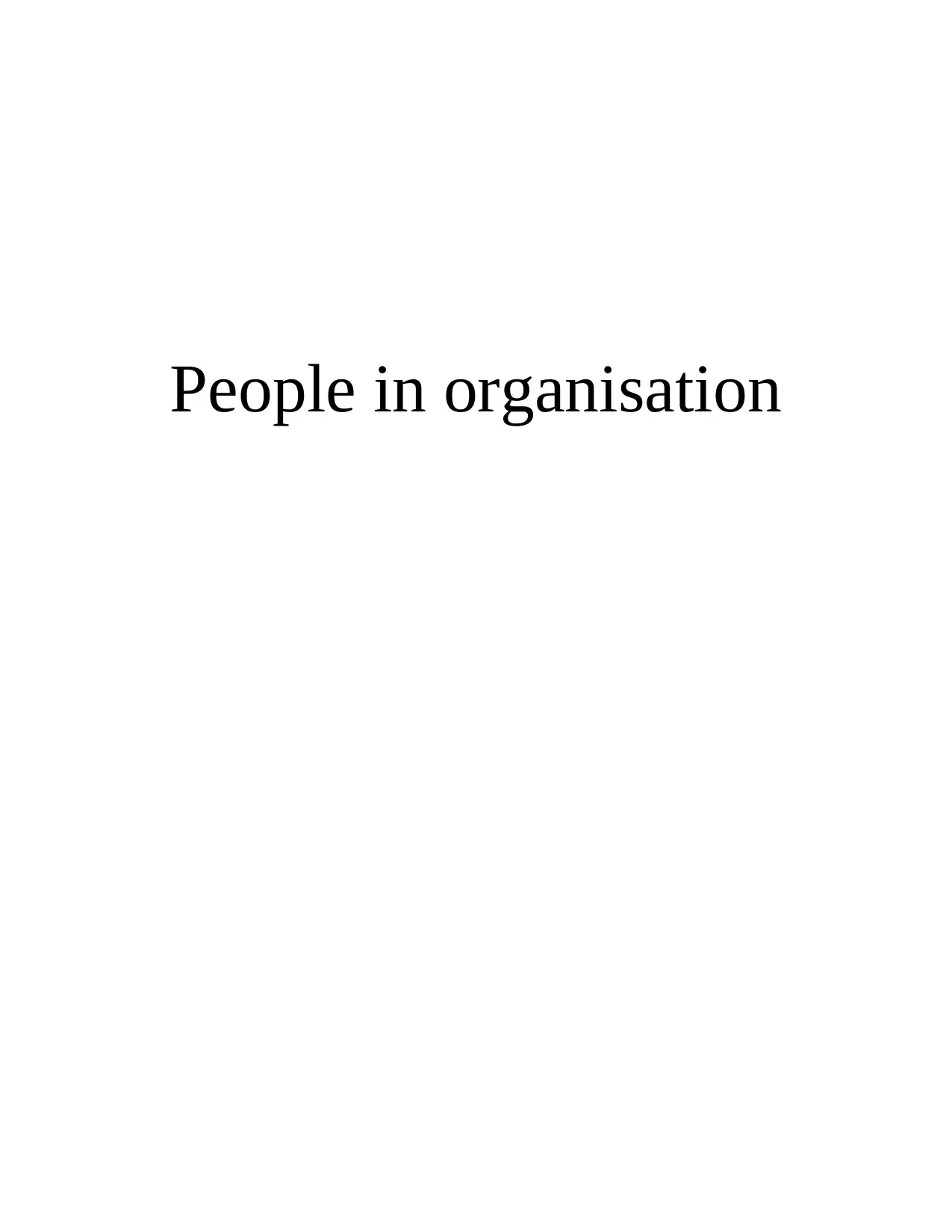
People in organisation
Secure Best Marks with AI Grader
Need help grading? Try our AI Grader for instant feedback on your assignments.
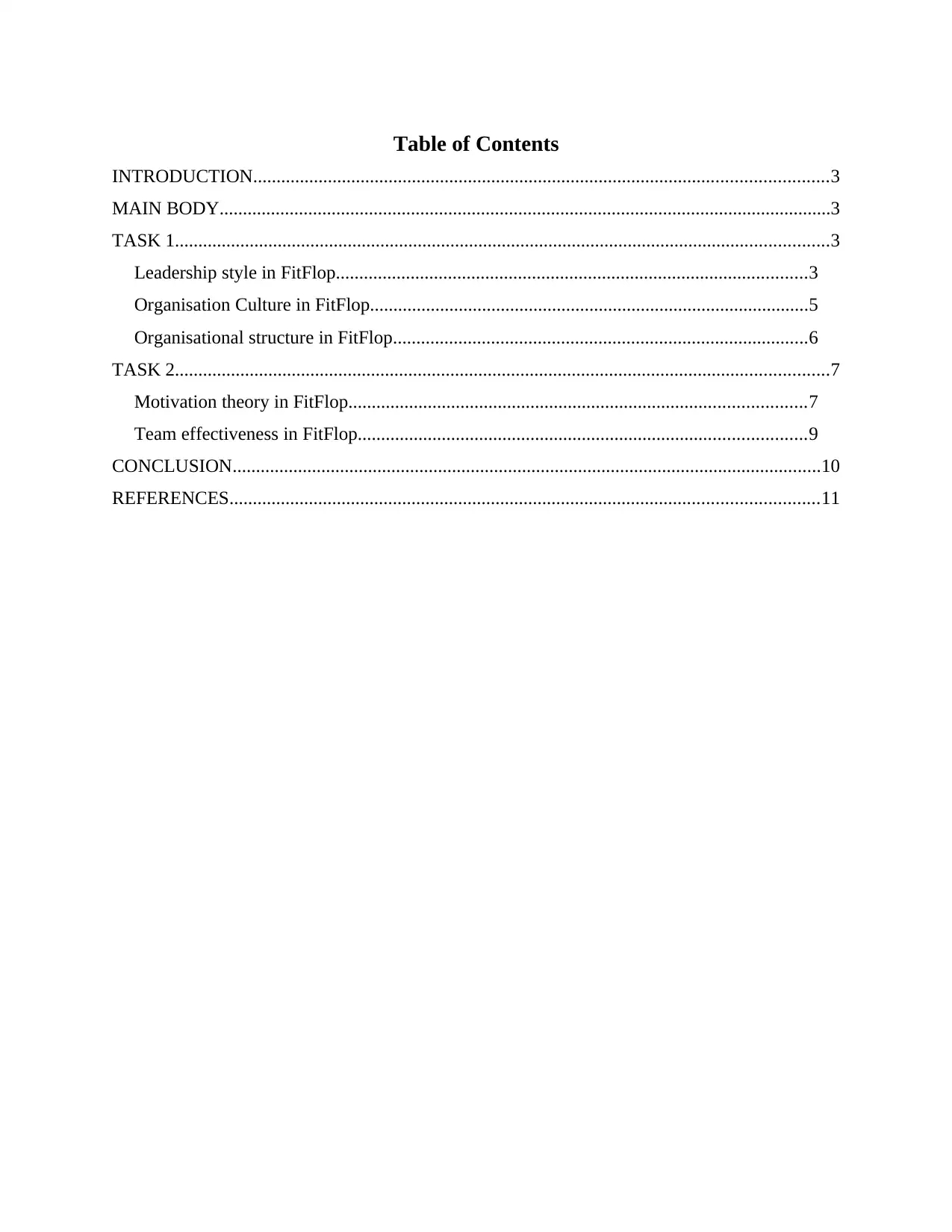
Table of Contents
INTRODUCTION...........................................................................................................................3
MAIN BODY...................................................................................................................................3
TASK 1............................................................................................................................................3
Leadership style in FitFlop.....................................................................................................3
Organisation Culture in FitFlop..............................................................................................5
Organisational structure in FitFlop.........................................................................................6
TASK 2............................................................................................................................................7
Motivation theory in FitFlop..................................................................................................7
Team effectiveness in FitFlop................................................................................................9
CONCLUSION..............................................................................................................................10
REFERENCES..............................................................................................................................11
INTRODUCTION...........................................................................................................................3
MAIN BODY...................................................................................................................................3
TASK 1............................................................................................................................................3
Leadership style in FitFlop.....................................................................................................3
Organisation Culture in FitFlop..............................................................................................5
Organisational structure in FitFlop.........................................................................................6
TASK 2............................................................................................................................................7
Motivation theory in FitFlop..................................................................................................7
Team effectiveness in FitFlop................................................................................................9
CONCLUSION..............................................................................................................................10
REFERENCES..............................................................................................................................11
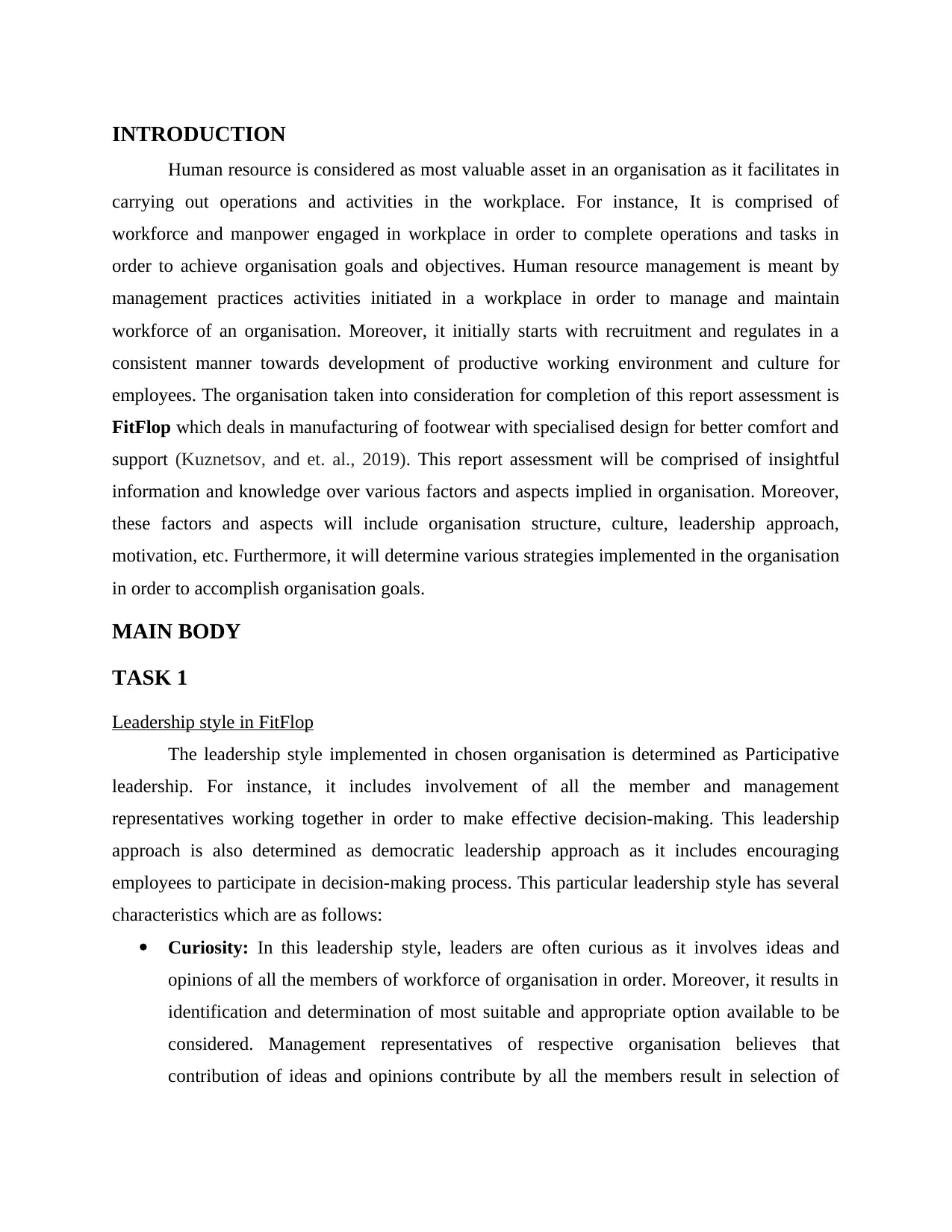
INTRODUCTION
Human resource is considered as most valuable asset in an organisation as it facilitates in
carrying out operations and activities in the workplace. For instance, It is comprised of
workforce and manpower engaged in workplace in order to complete operations and tasks in
order to achieve organisation goals and objectives. Human resource management is meant by
management practices activities initiated in a workplace in order to manage and maintain
workforce of an organisation. Moreover, it initially starts with recruitment and regulates in a
consistent manner towards development of productive working environment and culture for
employees. The organisation taken into consideration for completion of this report assessment is
FitFlop which deals in manufacturing of footwear with specialised design for better comfort and
support (Kuznetsov, and et. al., 2019). This report assessment will be comprised of insightful
information and knowledge over various factors and aspects implied in organisation. Moreover,
these factors and aspects will include organisation structure, culture, leadership approach,
motivation, etc. Furthermore, it will determine various strategies implemented in the organisation
in order to accomplish organisation goals.
MAIN BODY
TASK 1
Leadership style in FitFlop
The leadership style implemented in chosen organisation is determined as Participative
leadership. For instance, it includes involvement of all the member and management
representatives working together in order to make effective decision-making. This leadership
approach is also determined as democratic leadership approach as it includes encouraging
employees to participate in decision-making process. This particular leadership style has several
characteristics which are as follows:
Curiosity: In this leadership style, leaders are often curious as it involves ideas and
opinions of all the members of workforce of organisation in order. Moreover, it results in
identification and determination of most suitable and appropriate option available to be
considered. Management representatives of respective organisation believes that
contribution of ideas and opinions contribute by all the members result in selection of
Human resource is considered as most valuable asset in an organisation as it facilitates in
carrying out operations and activities in the workplace. For instance, It is comprised of
workforce and manpower engaged in workplace in order to complete operations and tasks in
order to achieve organisation goals and objectives. Human resource management is meant by
management practices activities initiated in a workplace in order to manage and maintain
workforce of an organisation. Moreover, it initially starts with recruitment and regulates in a
consistent manner towards development of productive working environment and culture for
employees. The organisation taken into consideration for completion of this report assessment is
FitFlop which deals in manufacturing of footwear with specialised design for better comfort and
support (Kuznetsov, and et. al., 2019). This report assessment will be comprised of insightful
information and knowledge over various factors and aspects implied in organisation. Moreover,
these factors and aspects will include organisation structure, culture, leadership approach,
motivation, etc. Furthermore, it will determine various strategies implemented in the organisation
in order to accomplish organisation goals.
MAIN BODY
TASK 1
Leadership style in FitFlop
The leadership style implemented in chosen organisation is determined as Participative
leadership. For instance, it includes involvement of all the member and management
representatives working together in order to make effective decision-making. This leadership
approach is also determined as democratic leadership approach as it includes encouraging
employees to participate in decision-making process. This particular leadership style has several
characteristics which are as follows:
Curiosity: In this leadership style, leaders are often curious as it involves ideas and
opinions of all the members of workforce of organisation in order. Moreover, it results in
identification and determination of most suitable and appropriate option available to be
considered. Management representatives of respective organisation believes that
contribution of ideas and opinions contribute by all the members result in selection of
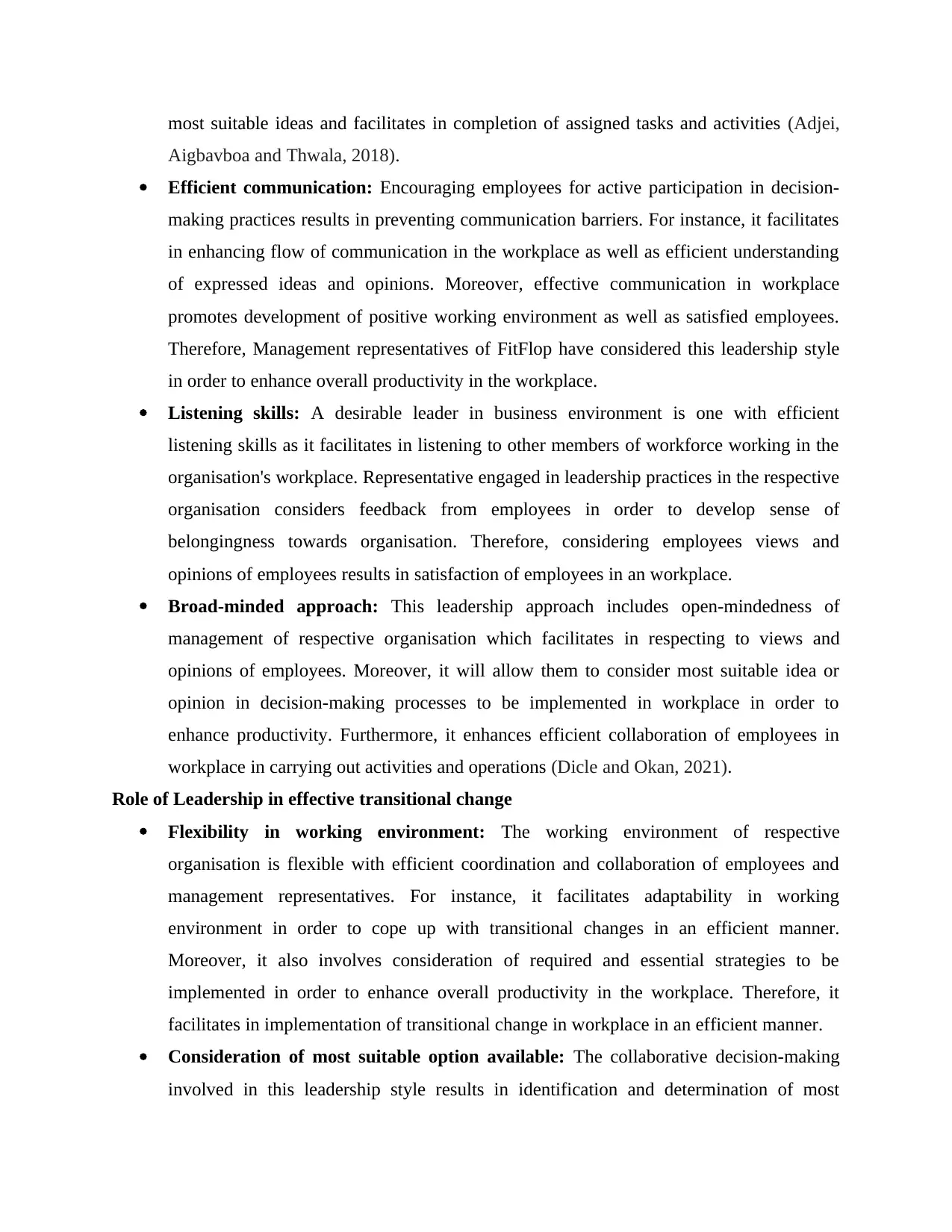
most suitable ideas and facilitates in completion of assigned tasks and activities (Adjei,
Aigbavboa and Thwala, 2018).
Efficient communication: Encouraging employees for active participation in decision-
making practices results in preventing communication barriers. For instance, it facilitates
in enhancing flow of communication in the workplace as well as efficient understanding
of expressed ideas and opinions. Moreover, effective communication in workplace
promotes development of positive working environment as well as satisfied employees.
Therefore, Management representatives of FitFlop have considered this leadership style
in order to enhance overall productivity in the workplace.
Listening skills: A desirable leader in business environment is one with efficient
listening skills as it facilitates in listening to other members of workforce working in the
organisation's workplace. Representative engaged in leadership practices in the respective
organisation considers feedback from employees in order to develop sense of
belongingness towards organisation. Therefore, considering employees views and
opinions of employees results in satisfaction of employees in an workplace.
Broad-minded approach: This leadership approach includes open-mindedness of
management of respective organisation which facilitates in respecting to views and
opinions of employees. Moreover, it will allow them to consider most suitable idea or
opinion in decision-making processes to be implemented in workplace in order to
enhance productivity. Furthermore, it enhances efficient collaboration of employees in
workplace in carrying out activities and operations (Dicle and Okan, 2021).
Role of Leadership in effective transitional change
Flexibility in working environment: The working environment of respective
organisation is flexible with efficient coordination and collaboration of employees and
management representatives. For instance, it facilitates adaptability in working
environment in order to cope up with transitional changes in an efficient manner.
Moreover, it also involves consideration of required and essential strategies to be
implemented in order to enhance overall productivity in the workplace. Therefore, it
facilitates in implementation of transitional change in workplace in an efficient manner.
Consideration of most suitable option available: The collaborative decision-making
involved in this leadership style results in identification and determination of most
Aigbavboa and Thwala, 2018).
Efficient communication: Encouraging employees for active participation in decision-
making practices results in preventing communication barriers. For instance, it facilitates
in enhancing flow of communication in the workplace as well as efficient understanding
of expressed ideas and opinions. Moreover, effective communication in workplace
promotes development of positive working environment as well as satisfied employees.
Therefore, Management representatives of FitFlop have considered this leadership style
in order to enhance overall productivity in the workplace.
Listening skills: A desirable leader in business environment is one with efficient
listening skills as it facilitates in listening to other members of workforce working in the
organisation's workplace. Representative engaged in leadership practices in the respective
organisation considers feedback from employees in order to develop sense of
belongingness towards organisation. Therefore, considering employees views and
opinions of employees results in satisfaction of employees in an workplace.
Broad-minded approach: This leadership approach includes open-mindedness of
management of respective organisation which facilitates in respecting to views and
opinions of employees. Moreover, it will allow them to consider most suitable idea or
opinion in decision-making processes to be implemented in workplace in order to
enhance productivity. Furthermore, it enhances efficient collaboration of employees in
workplace in carrying out activities and operations (Dicle and Okan, 2021).
Role of Leadership in effective transitional change
Flexibility in working environment: The working environment of respective
organisation is flexible with efficient coordination and collaboration of employees and
management representatives. For instance, it facilitates adaptability in working
environment in order to cope up with transitional changes in an efficient manner.
Moreover, it also involves consideration of required and essential strategies to be
implemented in order to enhance overall productivity in the workplace. Therefore, it
facilitates in implementation of transitional change in workplace in an efficient manner.
Consideration of most suitable option available: The collaborative decision-making
involved in this leadership style results in identification and determination of most
Secure Best Marks with AI Grader
Need help grading? Try our AI Grader for instant feedback on your assignments.
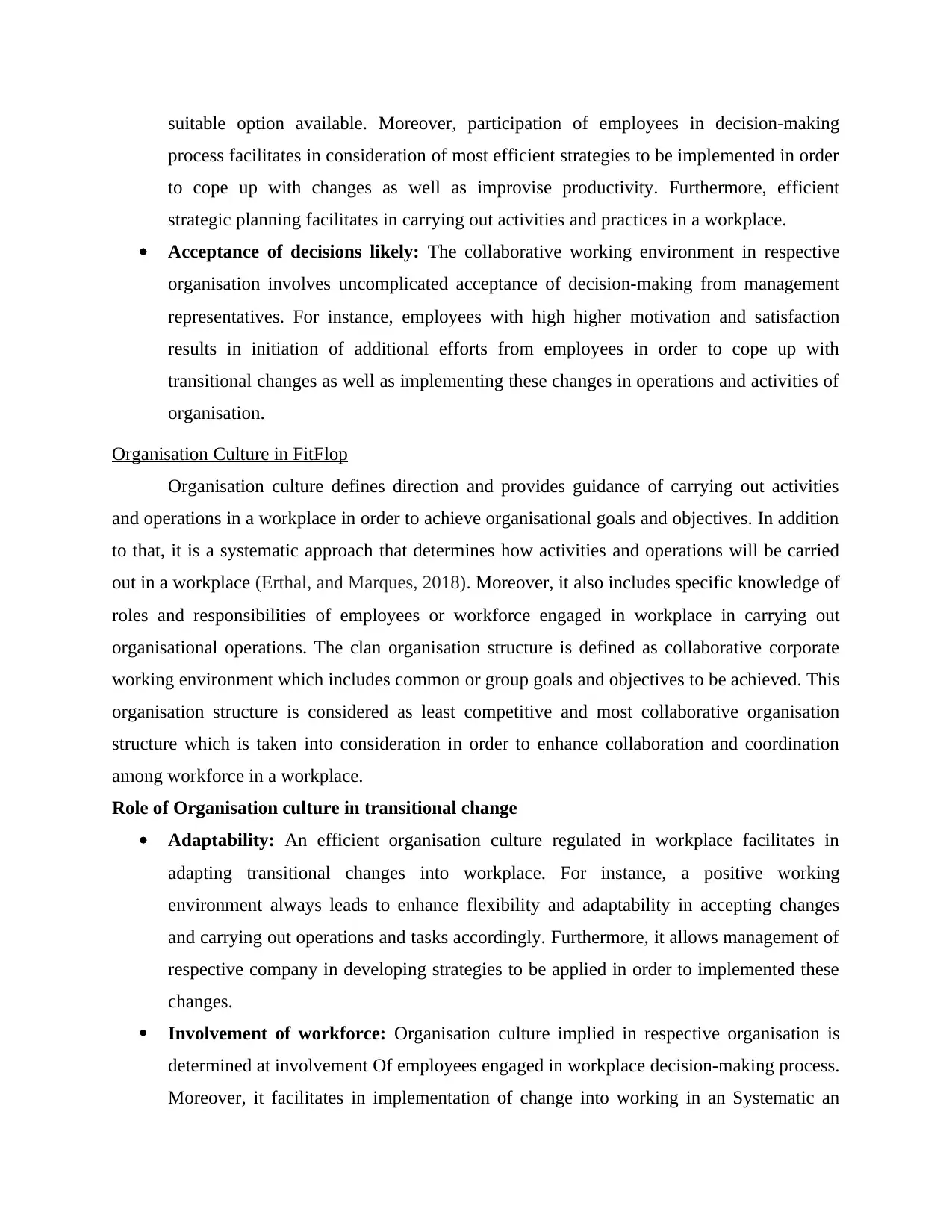
suitable option available. Moreover, participation of employees in decision-making
process facilitates in consideration of most efficient strategies to be implemented in order
to cope up with changes as well as improvise productivity. Furthermore, efficient
strategic planning facilitates in carrying out activities and practices in a workplace.
Acceptance of decisions likely: The collaborative working environment in respective
organisation involves uncomplicated acceptance of decision-making from management
representatives. For instance, employees with high higher motivation and satisfaction
results in initiation of additional efforts from employees in order to cope up with
transitional changes as well as implementing these changes in operations and activities of
organisation.
Organisation Culture in FitFlop
Organisation culture defines direction and provides guidance of carrying out activities
and operations in a workplace in order to achieve organisational goals and objectives. In addition
to that, it is a systematic approach that determines how activities and operations will be carried
out in a workplace (Erthal, and Marques, 2018). Moreover, it also includes specific knowledge of
roles and responsibilities of employees or workforce engaged in workplace in carrying out
organisational operations. The clan organisation structure is defined as collaborative corporate
working environment which includes common or group goals and objectives to be achieved. This
organisation structure is considered as least competitive and most collaborative organisation
structure which is taken into consideration in order to enhance collaboration and coordination
among workforce in a workplace.
Role of Organisation culture in transitional change
Adaptability: An efficient organisation culture regulated in workplace facilitates in
adapting transitional changes into workplace. For instance, a positive working
environment always leads to enhance flexibility and adaptability in accepting changes
and carrying out operations and tasks accordingly. Furthermore, it allows management of
respective company in developing strategies to be applied in order to implemented these
changes.
Involvement of workforce: Organisation culture implied in respective organisation is
determined at involvement Of employees engaged in workplace decision-making process.
Moreover, it facilitates in implementation of change into working in an Systematic an
process facilitates in consideration of most efficient strategies to be implemented in order
to cope up with changes as well as improvise productivity. Furthermore, efficient
strategic planning facilitates in carrying out activities and practices in a workplace.
Acceptance of decisions likely: The collaborative working environment in respective
organisation involves uncomplicated acceptance of decision-making from management
representatives. For instance, employees with high higher motivation and satisfaction
results in initiation of additional efforts from employees in order to cope up with
transitional changes as well as implementing these changes in operations and activities of
organisation.
Organisation Culture in FitFlop
Organisation culture defines direction and provides guidance of carrying out activities
and operations in a workplace in order to achieve organisational goals and objectives. In addition
to that, it is a systematic approach that determines how activities and operations will be carried
out in a workplace (Erthal, and Marques, 2018). Moreover, it also includes specific knowledge of
roles and responsibilities of employees or workforce engaged in workplace in carrying out
organisational operations. The clan organisation structure is defined as collaborative corporate
working environment which includes common or group goals and objectives to be achieved. This
organisation structure is considered as least competitive and most collaborative organisation
structure which is taken into consideration in order to enhance collaboration and coordination
among workforce in a workplace.
Role of Organisation culture in transitional change
Adaptability: An efficient organisation culture regulated in workplace facilitates in
adapting transitional changes into workplace. For instance, a positive working
environment always leads to enhance flexibility and adaptability in accepting changes
and carrying out operations and tasks accordingly. Furthermore, it allows management of
respective company in developing strategies to be applied in order to implemented these
changes.
Involvement of workforce: Organisation culture implied in respective organisation is
determined at involvement Of employees engaged in workplace decision-making process.
Moreover, it facilitates in implementation of change into working in an Systematic an
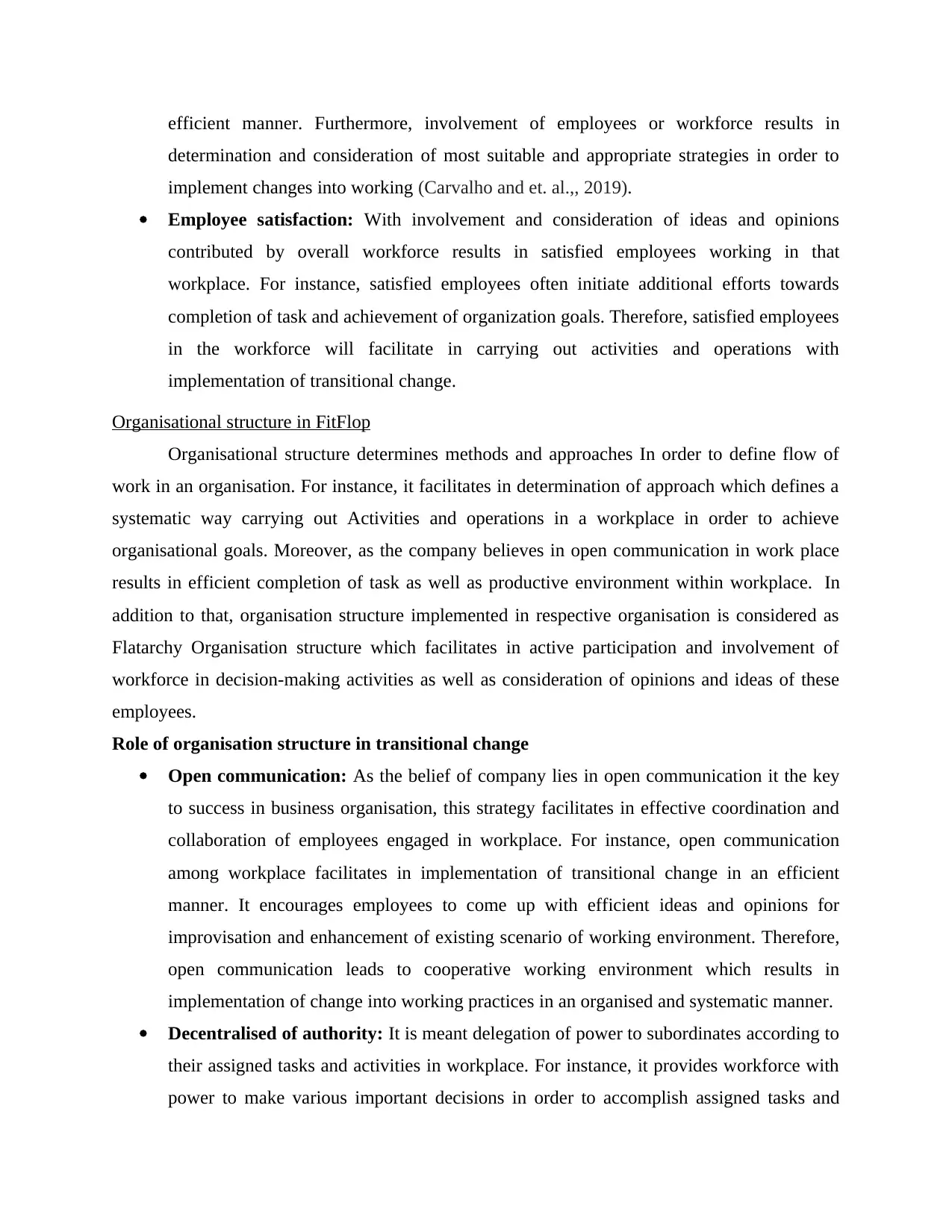
efficient manner. Furthermore, involvement of employees or workforce results in
determination and consideration of most suitable and appropriate strategies in order to
implement changes into working (Carvalho and et. al.,, 2019).
Employee satisfaction: With involvement and consideration of ideas and opinions
contributed by overall workforce results in satisfied employees working in that
workplace. For instance, satisfied employees often initiate additional efforts towards
completion of task and achievement of organization goals. Therefore, satisfied employees
in the workforce will facilitate in carrying out activities and operations with
implementation of transitional change.
Organisational structure in FitFlop
Organisational structure determines methods and approaches In order to define flow of
work in an organisation. For instance, it facilitates in determination of approach which defines a
systematic way carrying out Activities and operations in a workplace in order to achieve
organisational goals. Moreover, as the company believes in open communication in work place
results in efficient completion of task as well as productive environment within workplace. In
addition to that, organisation structure implemented in respective organisation is considered as
Flatarchy Organisation structure which facilitates in active participation and involvement of
workforce in decision-making activities as well as consideration of opinions and ideas of these
employees.
Role of organisation structure in transitional change
Open communication: As the belief of company lies in open communication it the key
to success in business organisation, this strategy facilitates in effective coordination and
collaboration of employees engaged in workplace. For instance, open communication
among workplace facilitates in implementation of transitional change in an efficient
manner. It encourages employees to come up with efficient ideas and opinions for
improvisation and enhancement of existing scenario of working environment. Therefore,
open communication leads to cooperative working environment which results in
implementation of change into working practices in an organised and systematic manner.
Decentralised of authority: It is meant delegation of power to subordinates according to
their assigned tasks and activities in workplace. For instance, it provides workforce with
power to make various important decisions in order to accomplish assigned tasks and
determination and consideration of most suitable and appropriate strategies in order to
implement changes into working (Carvalho and et. al.,, 2019).
Employee satisfaction: With involvement and consideration of ideas and opinions
contributed by overall workforce results in satisfied employees working in that
workplace. For instance, satisfied employees often initiate additional efforts towards
completion of task and achievement of organization goals. Therefore, satisfied employees
in the workforce will facilitate in carrying out activities and operations with
implementation of transitional change.
Organisational structure in FitFlop
Organisational structure determines methods and approaches In order to define flow of
work in an organisation. For instance, it facilitates in determination of approach which defines a
systematic way carrying out Activities and operations in a workplace in order to achieve
organisational goals. Moreover, as the company believes in open communication in work place
results in efficient completion of task as well as productive environment within workplace. In
addition to that, organisation structure implemented in respective organisation is considered as
Flatarchy Organisation structure which facilitates in active participation and involvement of
workforce in decision-making activities as well as consideration of opinions and ideas of these
employees.
Role of organisation structure in transitional change
Open communication: As the belief of company lies in open communication it the key
to success in business organisation, this strategy facilitates in effective coordination and
collaboration of employees engaged in workplace. For instance, open communication
among workplace facilitates in implementation of transitional change in an efficient
manner. It encourages employees to come up with efficient ideas and opinions for
improvisation and enhancement of existing scenario of working environment. Therefore,
open communication leads to cooperative working environment which results in
implementation of change into working practices in an organised and systematic manner.
Decentralised of authority: It is meant delegation of power to subordinates according to
their assigned tasks and activities in workplace. For instance, it provides workforce with
power to make various important decisions in order to accomplish assigned tasks and
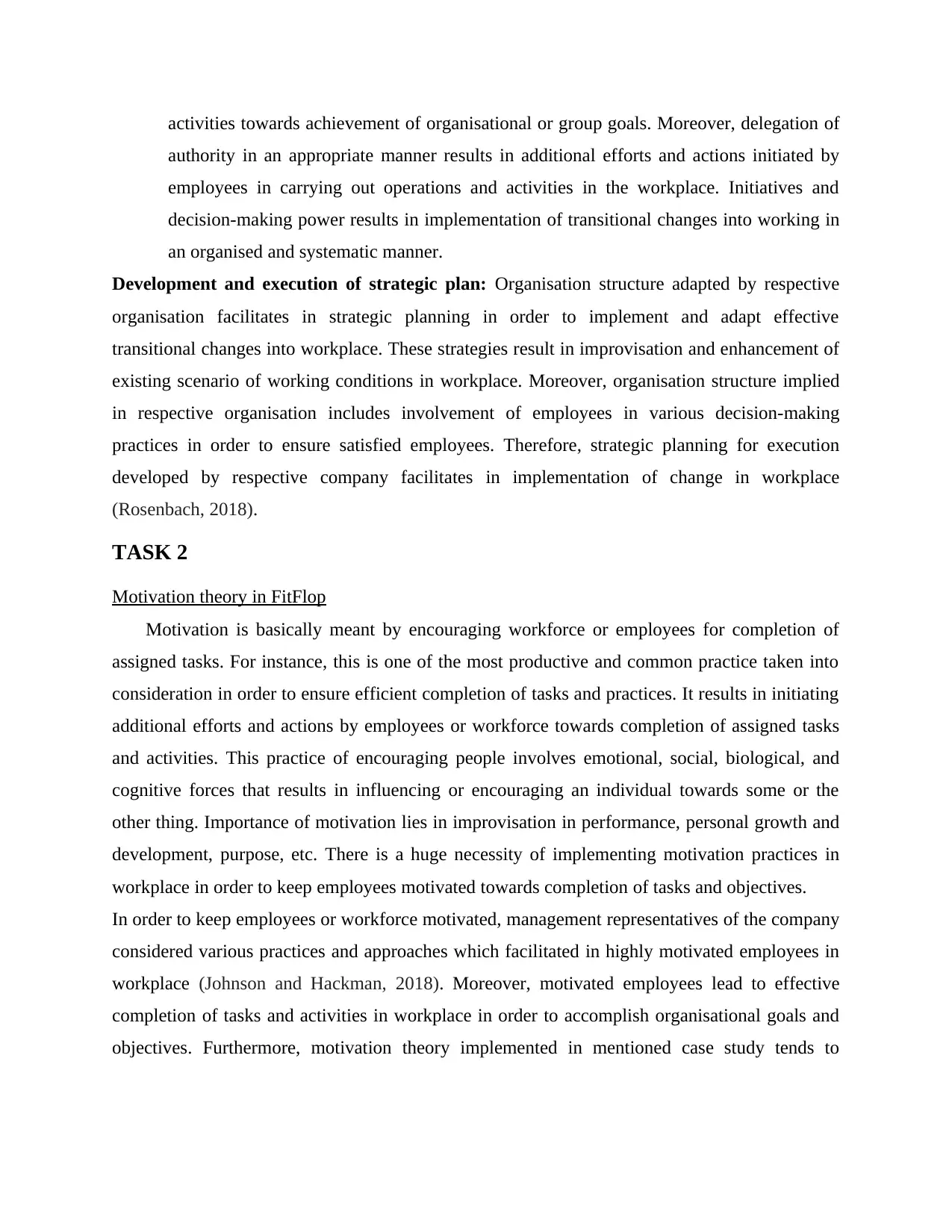
activities towards achievement of organisational or group goals. Moreover, delegation of
authority in an appropriate manner results in additional efforts and actions initiated by
employees in carrying out operations and activities in the workplace. Initiatives and
decision-making power results in implementation of transitional changes into working in
an organised and systematic manner.
Development and execution of strategic plan: Organisation structure adapted by respective
organisation facilitates in strategic planning in order to implement and adapt effective
transitional changes into workplace. These strategies result in improvisation and enhancement of
existing scenario of working conditions in workplace. Moreover, organisation structure implied
in respective organisation includes involvement of employees in various decision-making
practices in order to ensure satisfied employees. Therefore, strategic planning for execution
developed by respective company facilitates in implementation of change in workplace
(Rosenbach, 2018).
TASK 2
Motivation theory in FitFlop
Motivation is basically meant by encouraging workforce or employees for completion of
assigned tasks. For instance, this is one of the most productive and common practice taken into
consideration in order to ensure efficient completion of tasks and practices. It results in initiating
additional efforts and actions by employees or workforce towards completion of assigned tasks
and activities. This practice of encouraging people involves emotional, social, biological, and
cognitive forces that results in influencing or encouraging an individual towards some or the
other thing. Importance of motivation lies in improvisation in performance, personal growth and
development, purpose, etc. There is a huge necessity of implementing motivation practices in
workplace in order to keep employees motivated towards completion of tasks and objectives.
In order to keep employees or workforce motivated, management representatives of the company
considered various practices and approaches which facilitated in highly motivated employees in
workplace (Johnson and Hackman, 2018). Moreover, motivated employees lead to effective
completion of tasks and activities in workplace in order to accomplish organisational goals and
objectives. Furthermore, motivation theory implemented in mentioned case study tends to
authority in an appropriate manner results in additional efforts and actions initiated by
employees in carrying out operations and activities in the workplace. Initiatives and
decision-making power results in implementation of transitional changes into working in
an organised and systematic manner.
Development and execution of strategic plan: Organisation structure adapted by respective
organisation facilitates in strategic planning in order to implement and adapt effective
transitional changes into workplace. These strategies result in improvisation and enhancement of
existing scenario of working conditions in workplace. Moreover, organisation structure implied
in respective organisation includes involvement of employees in various decision-making
practices in order to ensure satisfied employees. Therefore, strategic planning for execution
developed by respective company facilitates in implementation of change in workplace
(Rosenbach, 2018).
TASK 2
Motivation theory in FitFlop
Motivation is basically meant by encouraging workforce or employees for completion of
assigned tasks. For instance, this is one of the most productive and common practice taken into
consideration in order to ensure efficient completion of tasks and practices. It results in initiating
additional efforts and actions by employees or workforce towards completion of assigned tasks
and activities. This practice of encouraging people involves emotional, social, biological, and
cognitive forces that results in influencing or encouraging an individual towards some or the
other thing. Importance of motivation lies in improvisation in performance, personal growth and
development, purpose, etc. There is a huge necessity of implementing motivation practices in
workplace in order to keep employees motivated towards completion of tasks and objectives.
In order to keep employees or workforce motivated, management representatives of the company
considered various practices and approaches which facilitated in highly motivated employees in
workplace (Johnson and Hackman, 2018). Moreover, motivated employees lead to effective
completion of tasks and activities in workplace in order to accomplish organisational goals and
objectives. Furthermore, motivation theory implemented in mentioned case study tends to
Paraphrase This Document
Need a fresh take? Get an instant paraphrase of this document with our AI Paraphraser
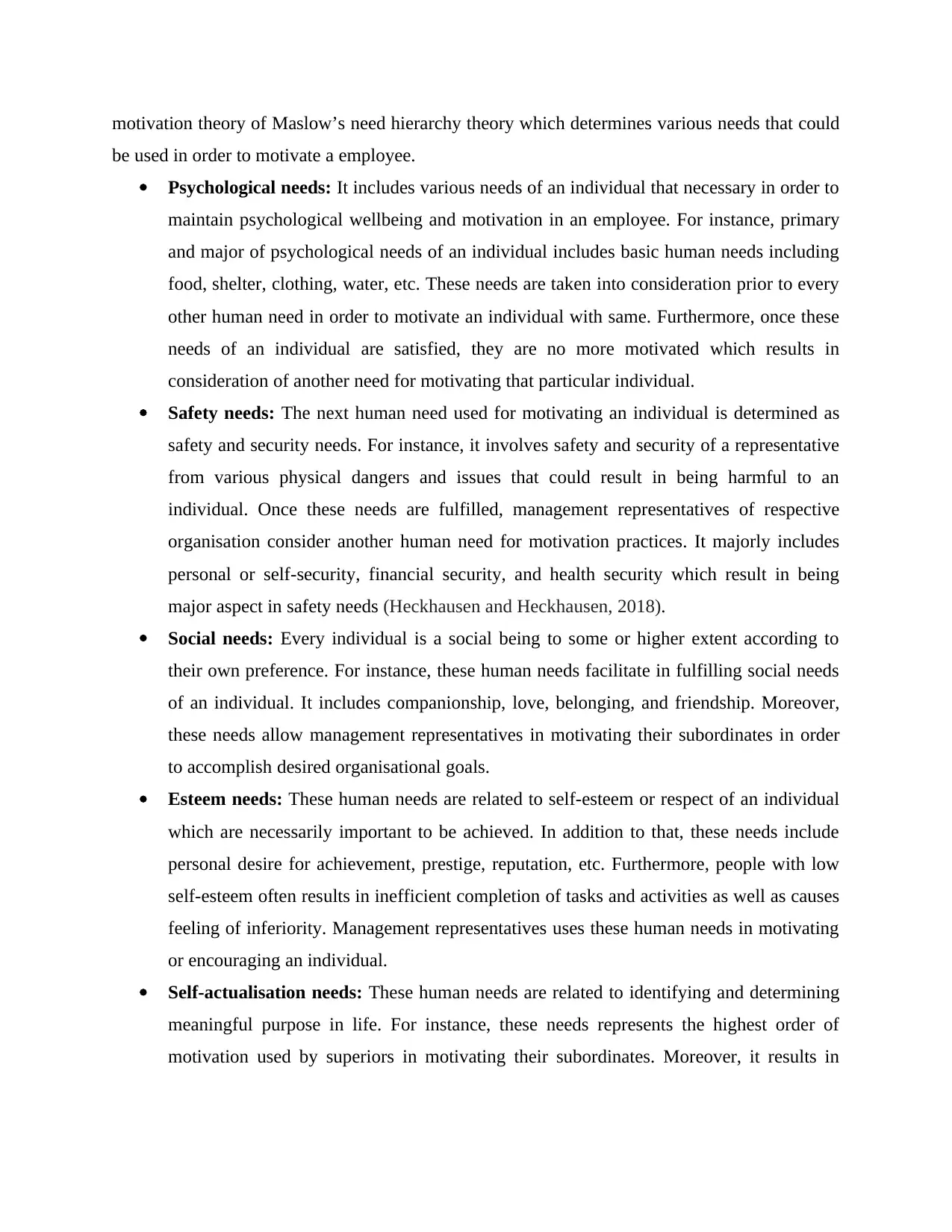
motivation theory of Maslow’s need hierarchy theory which determines various needs that could
be used in order to motivate a employee.
Psychological needs: It includes various needs of an individual that necessary in order to
maintain psychological wellbeing and motivation in an employee. For instance, primary
and major of psychological needs of an individual includes basic human needs including
food, shelter, clothing, water, etc. These needs are taken into consideration prior to every
other human need in order to motivate an individual with same. Furthermore, once these
needs of an individual are satisfied, they are no more motivated which results in
consideration of another need for motivating that particular individual.
Safety needs: The next human need used for motivating an individual is determined as
safety and security needs. For instance, it involves safety and security of a representative
from various physical dangers and issues that could result in being harmful to an
individual. Once these needs are fulfilled, management representatives of respective
organisation consider another human need for motivation practices. It majorly includes
personal or self-security, financial security, and health security which result in being
major aspect in safety needs (Heckhausen and Heckhausen, 2018).
Social needs: Every individual is a social being to some or higher extent according to
their own preference. For instance, these human needs facilitate in fulfilling social needs
of an individual. It includes companionship, love, belonging, and friendship. Moreover,
these needs allow management representatives in motivating their subordinates in order
to accomplish desired organisational goals.
Esteem needs: These human needs are related to self-esteem or respect of an individual
which are necessarily important to be achieved. In addition to that, these needs include
personal desire for achievement, prestige, reputation, etc. Furthermore, people with low
self-esteem often results in inefficient completion of tasks and activities as well as causes
feeling of inferiority. Management representatives uses these human needs in motivating
or encouraging an individual.
Self-actualisation needs: These human needs are related to identifying and determining
meaningful purpose in life. For instance, these needs represents the highest order of
motivation used by superiors in motivating their subordinates. Moreover, it results in
be used in order to motivate a employee.
Psychological needs: It includes various needs of an individual that necessary in order to
maintain psychological wellbeing and motivation in an employee. For instance, primary
and major of psychological needs of an individual includes basic human needs including
food, shelter, clothing, water, etc. These needs are taken into consideration prior to every
other human need in order to motivate an individual with same. Furthermore, once these
needs of an individual are satisfied, they are no more motivated which results in
consideration of another need for motivating that particular individual.
Safety needs: The next human need used for motivating an individual is determined as
safety and security needs. For instance, it involves safety and security of a representative
from various physical dangers and issues that could result in being harmful to an
individual. Once these needs are fulfilled, management representatives of respective
organisation consider another human need for motivation practices. It majorly includes
personal or self-security, financial security, and health security which result in being
major aspect in safety needs (Heckhausen and Heckhausen, 2018).
Social needs: Every individual is a social being to some or higher extent according to
their own preference. For instance, these human needs facilitate in fulfilling social needs
of an individual. It includes companionship, love, belonging, and friendship. Moreover,
these needs allow management representatives in motivating their subordinates in order
to accomplish desired organisational goals.
Esteem needs: These human needs are related to self-esteem or respect of an individual
which are necessarily important to be achieved. In addition to that, these needs include
personal desire for achievement, prestige, reputation, etc. Furthermore, people with low
self-esteem often results in inefficient completion of tasks and activities as well as causes
feeling of inferiority. Management representatives uses these human needs in motivating
or encouraging an individual.
Self-actualisation needs: These human needs are related to identifying and determining
meaningful purpose in life. For instance, these needs represents the highest order of
motivation used by superiors in motivating their subordinates. Moreover, it results in
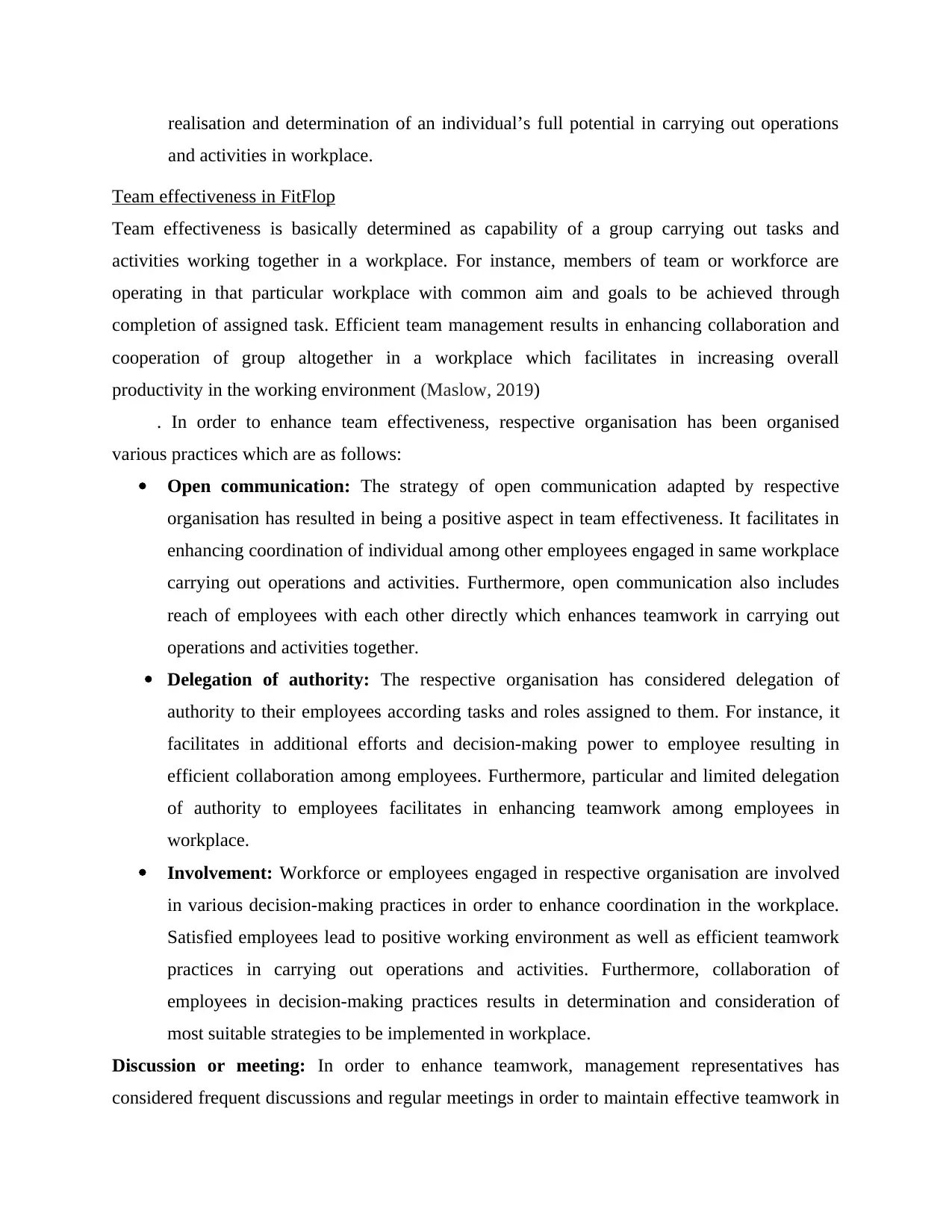
realisation and determination of an individual’s full potential in carrying out operations
and activities in workplace.
Team effectiveness in FitFlop
Team effectiveness is basically determined as capability of a group carrying out tasks and
activities working together in a workplace. For instance, members of team or workforce are
operating in that particular workplace with common aim and goals to be achieved through
completion of assigned task. Efficient team management results in enhancing collaboration and
cooperation of group altogether in a workplace which facilitates in increasing overall
productivity in the working environment (Maslow, 2019)
. In order to enhance team effectiveness, respective organisation has been organised
various practices which are as follows:
Open communication: The strategy of open communication adapted by respective
organisation has resulted in being a positive aspect in team effectiveness. It facilitates in
enhancing coordination of individual among other employees engaged in same workplace
carrying out operations and activities. Furthermore, open communication also includes
reach of employees with each other directly which enhances teamwork in carrying out
operations and activities together.
Delegation of authority: The respective organisation has considered delegation of
authority to their employees according tasks and roles assigned to them. For instance, it
facilitates in additional efforts and decision-making power to employee resulting in
efficient collaboration among employees. Furthermore, particular and limited delegation
of authority to employees facilitates in enhancing teamwork among employees in
workplace.
Involvement: Workforce or employees engaged in respective organisation are involved
in various decision-making practices in order to enhance coordination in the workplace.
Satisfied employees lead to positive working environment as well as efficient teamwork
practices in carrying out operations and activities. Furthermore, collaboration of
employees in decision-making practices results in determination and consideration of
most suitable strategies to be implemented in workplace.
Discussion or meeting: In order to enhance teamwork, management representatives has
considered frequent discussions and regular meetings in order to maintain effective teamwork in
and activities in workplace.
Team effectiveness in FitFlop
Team effectiveness is basically determined as capability of a group carrying out tasks and
activities working together in a workplace. For instance, members of team or workforce are
operating in that particular workplace with common aim and goals to be achieved through
completion of assigned task. Efficient team management results in enhancing collaboration and
cooperation of group altogether in a workplace which facilitates in increasing overall
productivity in the working environment (Maslow, 2019)
. In order to enhance team effectiveness, respective organisation has been organised
various practices which are as follows:
Open communication: The strategy of open communication adapted by respective
organisation has resulted in being a positive aspect in team effectiveness. It facilitates in
enhancing coordination of individual among other employees engaged in same workplace
carrying out operations and activities. Furthermore, open communication also includes
reach of employees with each other directly which enhances teamwork in carrying out
operations and activities together.
Delegation of authority: The respective organisation has considered delegation of
authority to their employees according tasks and roles assigned to them. For instance, it
facilitates in additional efforts and decision-making power to employee resulting in
efficient collaboration among employees. Furthermore, particular and limited delegation
of authority to employees facilitates in enhancing teamwork among employees in
workplace.
Involvement: Workforce or employees engaged in respective organisation are involved
in various decision-making practices in order to enhance coordination in the workplace.
Satisfied employees lead to positive working environment as well as efficient teamwork
practices in carrying out operations and activities. Furthermore, collaboration of
employees in decision-making practices results in determination and consideration of
most suitable strategies to be implemented in workplace.
Discussion or meeting: In order to enhance teamwork, management representatives has
considered frequent discussions and regular meetings in order to maintain effective teamwork in
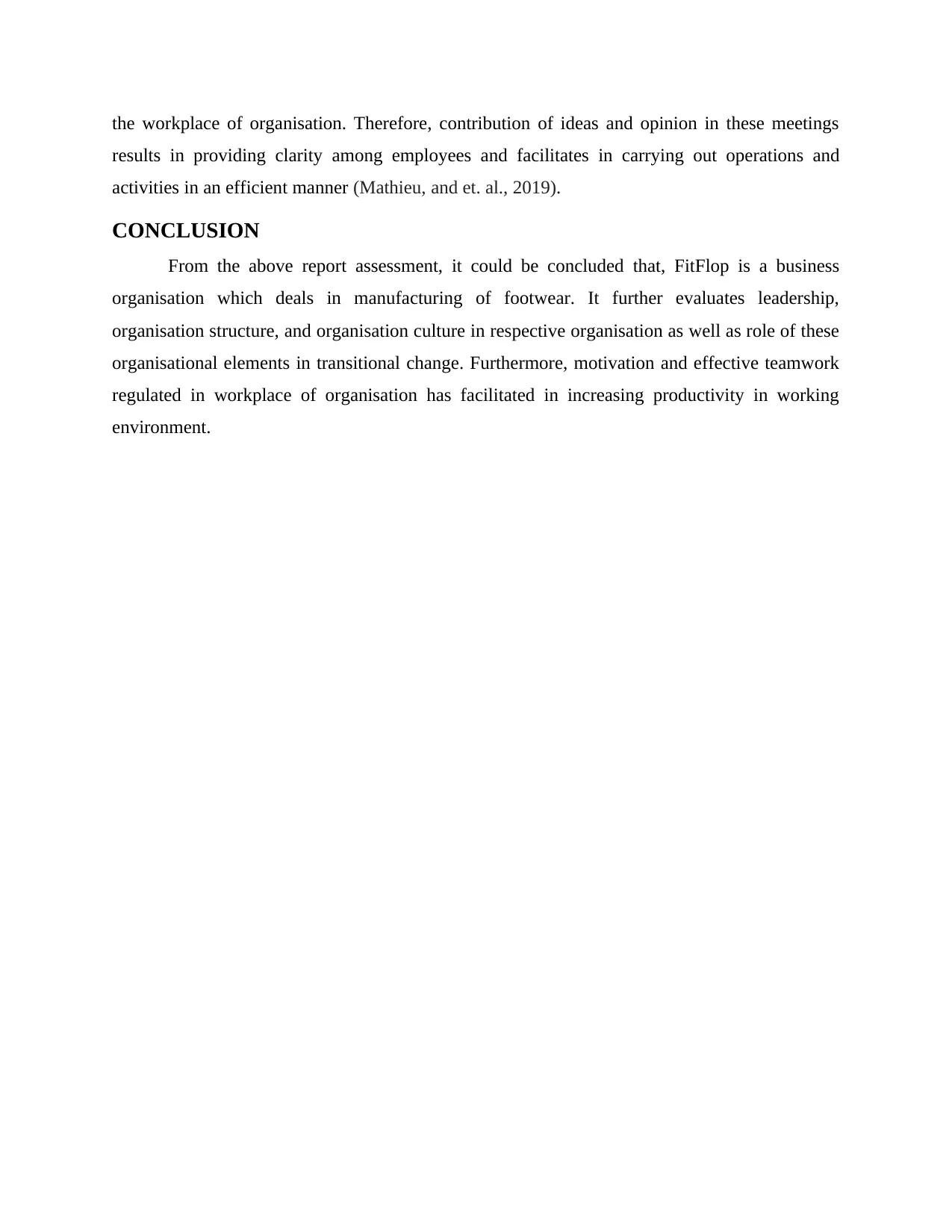
the workplace of organisation. Therefore, contribution of ideas and opinion in these meetings
results in providing clarity among employees and facilitates in carrying out operations and
activities in an efficient manner (Mathieu, and et. al., 2019).
CONCLUSION
From the above report assessment, it could be concluded that, FitFlop is a business
organisation which deals in manufacturing of footwear. It further evaluates leadership,
organisation structure, and organisation culture in respective organisation as well as role of these
organisational elements in transitional change. Furthermore, motivation and effective teamwork
regulated in workplace of organisation has facilitated in increasing productivity in working
environment.
results in providing clarity among employees and facilitates in carrying out operations and
activities in an efficient manner (Mathieu, and et. al., 2019).
CONCLUSION
From the above report assessment, it could be concluded that, FitFlop is a business
organisation which deals in manufacturing of footwear. It further evaluates leadership,
organisation structure, and organisation culture in respective organisation as well as role of these
organisational elements in transitional change. Furthermore, motivation and effective teamwork
regulated in workplace of organisation has facilitated in increasing productivity in working
environment.
Secure Best Marks with AI Grader
Need help grading? Try our AI Grader for instant feedback on your assignments.
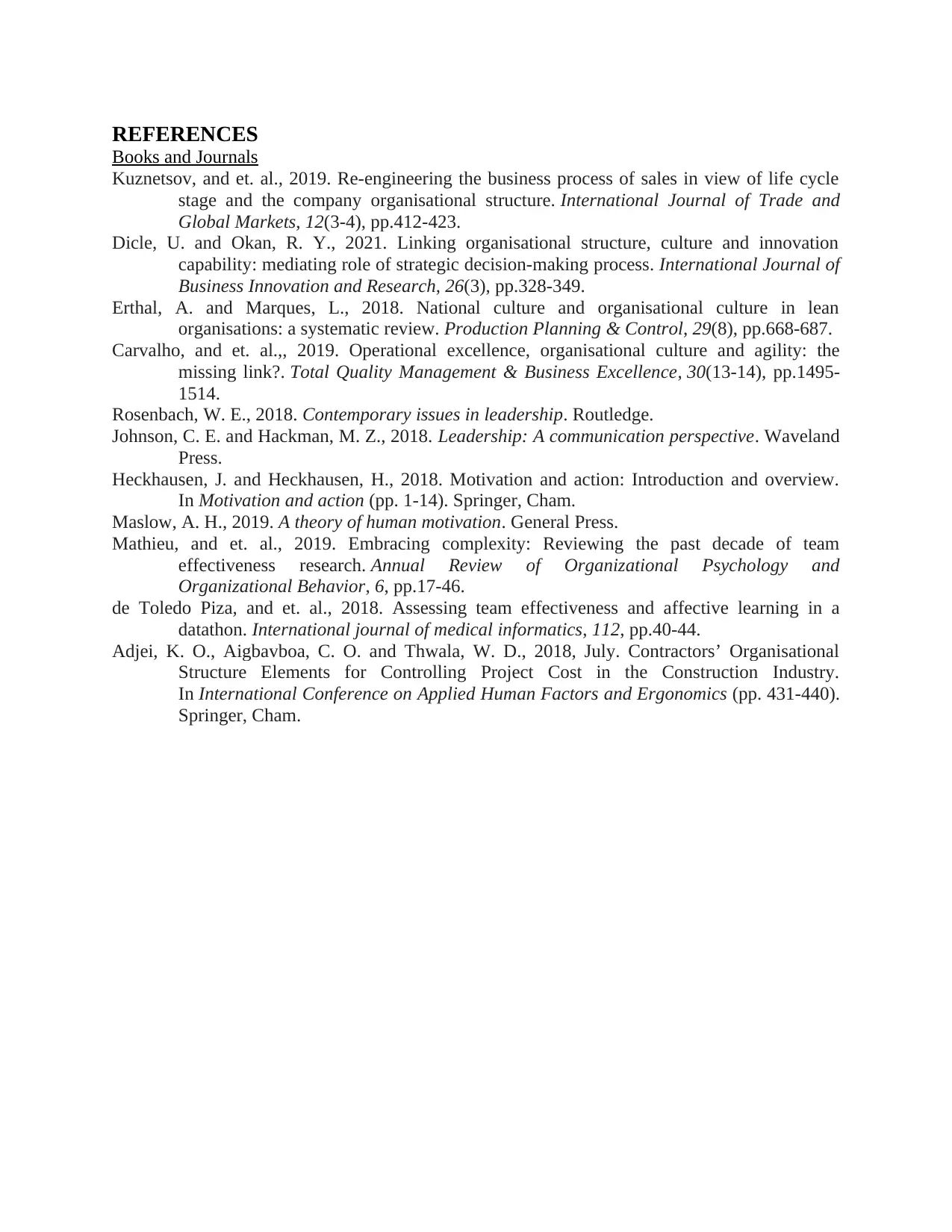
REFERENCES
Books and Journals
Kuznetsov, and et. al., 2019. Re-engineering the business process of sales in view of life cycle
stage and the company organisational structure. International Journal of Trade and
Global Markets, 12(3-4), pp.412-423.
Dicle, U. and Okan, R. Y., 2021. Linking organisational structure, culture and innovation
capability: mediating role of strategic decision-making process. International Journal of
Business Innovation and Research, 26(3), pp.328-349.
Erthal, A. and Marques, L., 2018. National culture and organisational culture in lean
organisations: a systematic review. Production Planning & Control, 29(8), pp.668-687.
Carvalho, and et. al.,, 2019. Operational excellence, organisational culture and agility: the
missing link?. Total Quality Management & Business Excellence, 30(13-14), pp.1495-
1514.
Rosenbach, W. E., 2018. Contemporary issues in leadership. Routledge.
Johnson, C. E. and Hackman, M. Z., 2018. Leadership: A communication perspective. Waveland
Press.
Heckhausen, J. and Heckhausen, H., 2018. Motivation and action: Introduction and overview.
In Motivation and action (pp. 1-14). Springer, Cham.
Maslow, A. H., 2019. A theory of human motivation. General Press.
Mathieu, and et. al., 2019. Embracing complexity: Reviewing the past decade of team
effectiveness research. Annual Review of Organizational Psychology and
Organizational Behavior, 6, pp.17-46.
de Toledo Piza, and et. al., 2018. Assessing team effectiveness and affective learning in a
datathon. International journal of medical informatics, 112, pp.40-44.
Adjei, K. O., Aigbavboa, C. O. and Thwala, W. D., 2018, July. Contractors’ Organisational
Structure Elements for Controlling Project Cost in the Construction Industry.
In International Conference on Applied Human Factors and Ergonomics (pp. 431-440).
Springer, Cham.
Books and Journals
Kuznetsov, and et. al., 2019. Re-engineering the business process of sales in view of life cycle
stage and the company organisational structure. International Journal of Trade and
Global Markets, 12(3-4), pp.412-423.
Dicle, U. and Okan, R. Y., 2021. Linking organisational structure, culture and innovation
capability: mediating role of strategic decision-making process. International Journal of
Business Innovation and Research, 26(3), pp.328-349.
Erthal, A. and Marques, L., 2018. National culture and organisational culture in lean
organisations: a systematic review. Production Planning & Control, 29(8), pp.668-687.
Carvalho, and et. al.,, 2019. Operational excellence, organisational culture and agility: the
missing link?. Total Quality Management & Business Excellence, 30(13-14), pp.1495-
1514.
Rosenbach, W. E., 2018. Contemporary issues in leadership. Routledge.
Johnson, C. E. and Hackman, M. Z., 2018. Leadership: A communication perspective. Waveland
Press.
Heckhausen, J. and Heckhausen, H., 2018. Motivation and action: Introduction and overview.
In Motivation and action (pp. 1-14). Springer, Cham.
Maslow, A. H., 2019. A theory of human motivation. General Press.
Mathieu, and et. al., 2019. Embracing complexity: Reviewing the past decade of team
effectiveness research. Annual Review of Organizational Psychology and
Organizational Behavior, 6, pp.17-46.
de Toledo Piza, and et. al., 2018. Assessing team effectiveness and affective learning in a
datathon. International journal of medical informatics, 112, pp.40-44.
Adjei, K. O., Aigbavboa, C. O. and Thwala, W. D., 2018, July. Contractors’ Organisational
Structure Elements for Controlling Project Cost in the Construction Industry.
In International Conference on Applied Human Factors and Ergonomics (pp. 431-440).
Springer, Cham.
1 out of 11
Related Documents
Your All-in-One AI-Powered Toolkit for Academic Success.
+13062052269
info@desklib.com
Available 24*7 on WhatsApp / Email
![[object Object]](/_next/static/media/star-bottom.7253800d.svg)
Unlock your academic potential
© 2024 | Zucol Services PVT LTD | All rights reserved.


